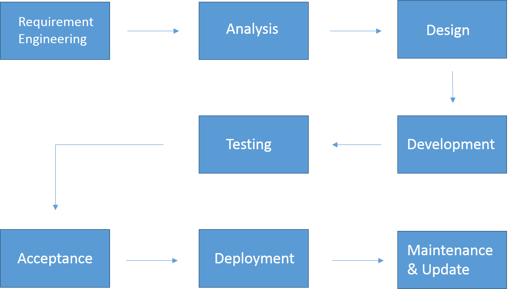
Building a software application is a complex process, comprising of a number of elements of which coding is just a small part. In general, a software engineering cycle looks something like this:

A business analyst gathers business requirements from the stakeholders and this information is then converted into a format that can be used by developers to start building the software (such as creating user stories). In the design phase, the architecture of the software is defined and documented, followed by coding and testing the outcome. Once the coded elements are accepted, they are deployed to the production server and then maintained or updated regularly. This is how a comprehensive software solution is developed.
In this segment, we are going to discuss the least talked about and yet the most significant element of a software development cycle- the software architecture. We will also take a look at some of the popular software architectures out there. Let’s get started.
What is Software Architecture?
“Software architecture defines how the components of a software system should be organized/assembled, how they communicate with each other, and what are the constraints the whole system is ruled by.”
So, by definition, there are three critical components of software architecture:
1. Architectural Pattern
The architectural pattern defines the granularity of a component, i.e. how big or small a component can be. For example, A Service-Oriented Architecture (SOA) will have bigger sized independent components than Microservices. Depending upon the application type, requirements, and dependencies, a relevant architecture pattern is selected before the development starts. Herein, an architecture acts as an input to the development team.
ALSO READ: Microservices vs Service-Oriented Architecture (SOA): Fundamental Differences
2. System InteractionSoftware architecture defines how the components communicate with each other. It includes the interfaces through which the system interacts. What would be the messaging mechanism, how software components will interact with the APIs, and more.
3. Quality Attributes
Quality attributes, such as scalability, resolvability, adaptability, resilience, etc. When designing software, it is imperative to consider all failures and design a fail-proof solution (apart from requirement gathering for what’s needed). But since the software today are complex, it is not possible to identify any impending error, anyway that it could crash, or produce some unexpected output. Software architecture defines such attributes so that a scalable, trustworthy solution is developed.
Benefits of Software Architecture
- Designing a software architecture discusses factors that can impact development, deployment, and maintenance cycle. Keeping high-impact factors into consideration helps to prevent schedule and budget outruns.
- It thoroughly scrutinizes the behavior of the software system before it is actually built. Such an analysis enables a software engineering team to inform stakeholders about the expected output of their requirements. This not only mitigates risks but also saves substantial costs that could go in building or changing parts of the solution.
- Designing architecture identifies the re-usable elements that can be used for building the solution. Reusable components boost up the software development cycle and can be used across multiple systems whose stakeholders require similar attributes or functionality in a solution.
Software Architectures: Examples
The software architecture space has evolved over time. Layered, monolithic, microservices, serverless, component-based- there are a number of ways software can be structured and its elements are made to interact with each other. You can understand more about them through the links shared below.
- Serverless Architecture: Benefits of Software Development With Serverless Architecture
- Monolithic and Microservices: Fundamental Differences between Monolithic and Microservices Architecture
- Component Based Architecture: Low Code Development: A Component based Approach to Software Development
While a number of architectures exist to make software development scalable, cost-effective, and fault-resistant, it is important to decide which one compliments your solution well. At Daffodil, we give preference to software architecture before commencing software development.
Want to know which software architecture works best for your solution? Set-up a free consultation with our software architect, who will understand your business to offer best architecture recommendation.



